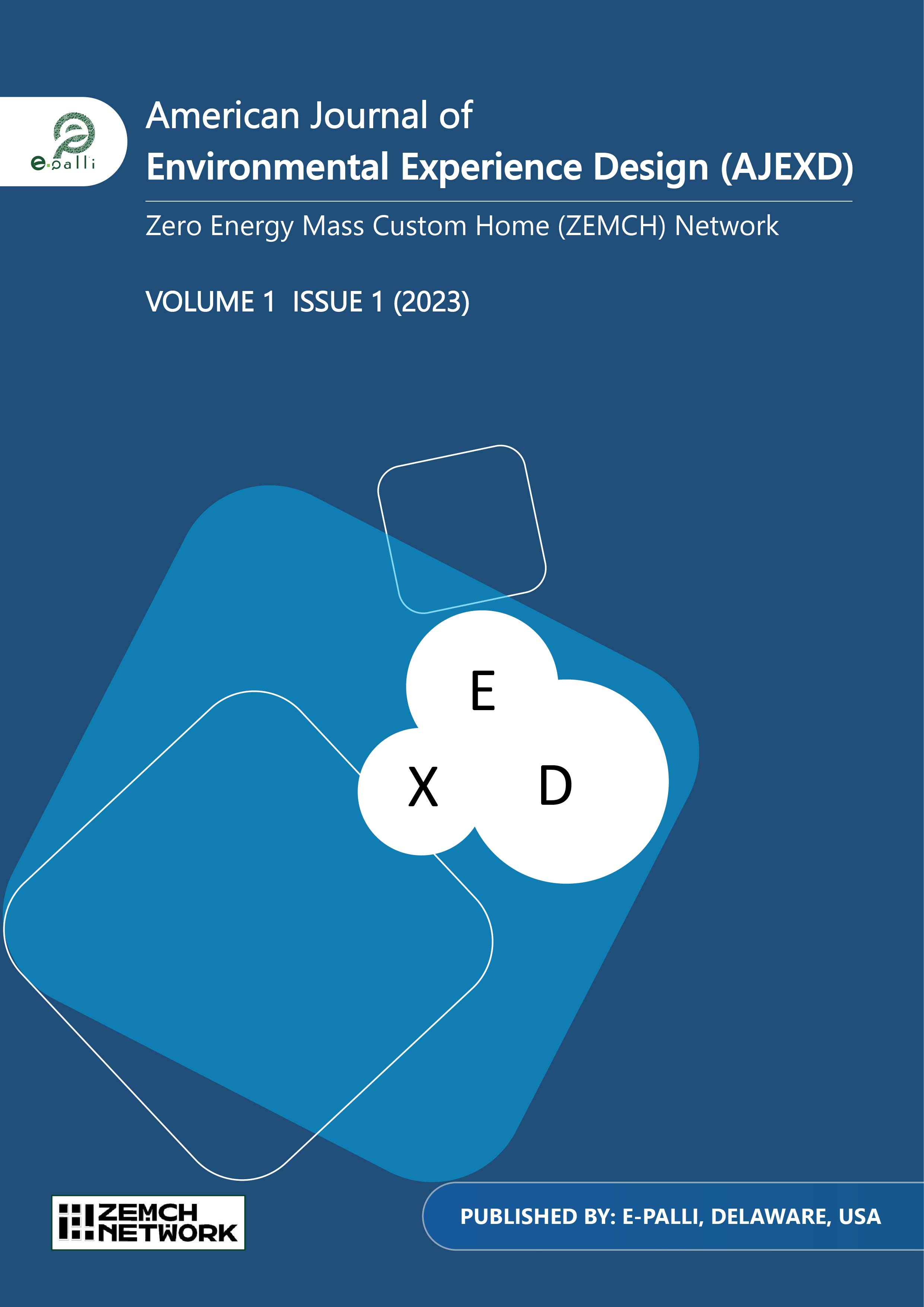Analysis of Indoor Air Quality of a Multi-storied Residential Kitchen in the Tropics
Keywords:
Human Health, Indoor Air Quality, Kitchen, Thermal Comfort, Tropical ClimateAbstract
Human body has a thermo receptor which is non-specialized sensory receptor that has relative changes in temperature. Thermal comfort is a very important element for human body so as indoor air. But the good indoor air quality and thermal comfort in the kitchen is often forgotten even though kitchen is an important part of every residence. Cooking in the kitchen is a routine activity which is done from the morning to the evening in most of the tropical countries. But the domestic smoke exposure and thermal strain caused by the kitchen environment for a long period of time increase the risk of common and serious diseases of the users. The aim of the study is to analyse the Indoor Air Quality (IAQ) and thermal comfort of the kitchen environment in the tropical climate and its impact on human health. One residential kitchen of a multi-storied building is observed on the basis of some Subjective Judgment Scales (SJS) including the Air Temperature, 0C (AT), Relative Humidity, % (RH), Indoor Air Quality Index (IAQI), Blood Pressure (BP), Pulse Rate (PR) and overall thermal sensation of the occupant at different conditions. Then the physical environment of the kitchen was analysed through digital documentation and simulation which included poor ventilation, presence of highly heat conductive surfaces etc. A questionnaire survey has also been conducted on 25 families regarding thermal comfort in the kitchen environment and to analyse how the Indoor Air Quality (IAQ) of the kitchen imposes severe health impacts on its users leading to some major health issues. The results indicate that the longer exposure to the heated kitchen environment directly affects the Indoor Air Quality (IAQ) of the kitchen for which the users are experienced with extreme thermal discomfort contributing to their degrading health conditions.
References
Adekunle, T. (2014). Post-occupancy and indoor monitoring surveys to investigate the potential of summertime overheating in UK prefabricated timber houses. https://api.semanticscholar.org/CorpusID:53314196
Baderoon, G. (2002). Everybody’s Mother Was a Good Cook: Meanings of Food in Muslim Cooking, Agenda, 17 (51), 4–15.
Chiang, C., Lai, C. M., Chou, P., & Li, Y. (2000). The influence of an architectural design alternative (transoms) on indoor air environment in conventional kitchens in Taiwan. Building and Environment, 35(7), 579–585. https://doi.org/10.1016/s0360-1323(99)00029-3
Chowdhury, Z., Le, L. T., Masud, A. A., Chang, K. C., Alauddin, M., Hossain, M., Zakaria, A., & Hopke, P. K. (2012). Quantification of Indoor Air Pollution from Using Cookstoves and Estimation of Its Health Effects on Adult Women in Northwest Bangladesh. Aerosol and Air Quality Research, 12(4), 463–475. https://doi.org/10.4209/aaqr.2011.10.0161
Cooper, A. (1998c). “A Woman’s Place is in the Kitchen”: The Evolution of Women Chefs. John Wiley & Sons Incorporated. (Book)
De Liège, U.-. U. (2013b, August 5). Study on indoor thermal comfort in the residential buildings of Liege, Belgium. http://orbi.ulg.ac.be/handle/2268/155634
Djamila, H., Chu, C., & Kumaresan, S. (2014d). Effect of humidity on thermal comfort in the humid tropics. Journal of Building Construction and Planning Research, 02(02), 109–117. https://doi.org/10.4236/jbcpr.2014.22010.
Fadil, N., and M. Fernando. (2015). Rediscovering the “Everyday” Muslim: Notes on an Anthropological Divide HAU. Journal of Ethnographic Theory, 5(2), 59–88.
Haruyama, Y., Muto, T., Matsuzuki, H., Ito, A., Tomita, S., Muto, S., Haratani, T., Seo, A., Ayabe, M. , & Katamoto, S. (2010). Evaluation of subjective thermal strain in different kitchen working environments using subjective judgment scales. Industrial Health, 48(2), 135–144. https://doi.org/10.2486/indhealth.48.135
Heinecke, R. (2021). Calculating an actionable indoor air quality index. Breeze Technologies. https://www.breeze-technologies.de/blog/calculating-an-actionable-indoor-air-quality-index/
Li, Y. (2001). The Science of Clothing Comfort. Textile Progress, 31(1–2), 1–135. https://doi.org/10.1080/00405160108688951
Matsuzuki, H., Ito, A., Ayabe, M., Haruyama, Y., Tomita, S., Katamoto, S., & Muto, T. (2011). The effects of work environments on thermal strain on workers in commercial kitchens. Industrial Health, 49(5), 605–613. https://doi.org/10.2486/indhealth.ms1219Nunneley, S. A. (1978). Physiological responses of women to thermal stress: a review. Med Sci Sports 10, 250–5.
Nunneley, S. A., Dowd, P. J., Myhre, L. G., & Stribley, R. F. (1978). Physiological and psychological effects of heat stress simulating cockpit conditions. Aviation, Space, and Environmental Medicine, 49, 763–767.
Platzer, R. (2011b). Women not in the kitchen: A look at gender equality in the restaurant industry. https://api.semanticscholar.org/CorpusID:140386134
Rahmillah, F. I., Tumanggor, A. H. U., & Sari, A. D. (2017). The analysis of thermal comfort in kitchen. IOP Conference Series, 215, 012033. https://doi.org/10.1088/1757-899x/215/1/012033
Schielke, S. (2015). Living with Unresolved Differences: A Reply to Fadil and Fernando. HAU, Journal of Ethnographic Theory, 5(2), 89–92. (Journal article)
Schielke, S., and L. Debevec, eds. (2012). Ordinary Lives and Grand Schemes: An Anthropology of Everyday Religion. New York. Berghahn Books.
Simone, A., & Olesen, B. W. (2013). Thermal environment evaluation in commercial Kitchens of United States, 1–4.
Wang, L., & Hien, W. N. (2011). Applying natural ventilation for thermal comfort in Residential buildings in Singapore. Architectural Science Review, 50(3), 224–233. https://doi.org/10.3763/asre.2007.5028 )
Wolf, S. T., Bernard, T. E., & Kenney, W. L. (2022b). Heat exposure limits for young unacclimatized males and females at low and high humidity. Journal of Occupational and Environmental Hygiene, 19(7), 415–424. https://doi.org/10.1080/15459624.2022.2076859
Inoue, Y., Nakao, M., Araki, T., & Ueda, H. (1992). Thermoregulatory responses of young and older men to cold exposure. European Journal of Applied Physiology, 65(6), 492–498. https://doi.org/10.1007/bf00602354.
Downloads
Published
Issue
Section
License
Copyright (c) 2023 Rubaiat Jannat, Sadia Tabassum Surovi, Labanya Sarker, Labiba Morshed Mitu

This work is licensed under a Creative Commons Attribution 4.0 International License.





